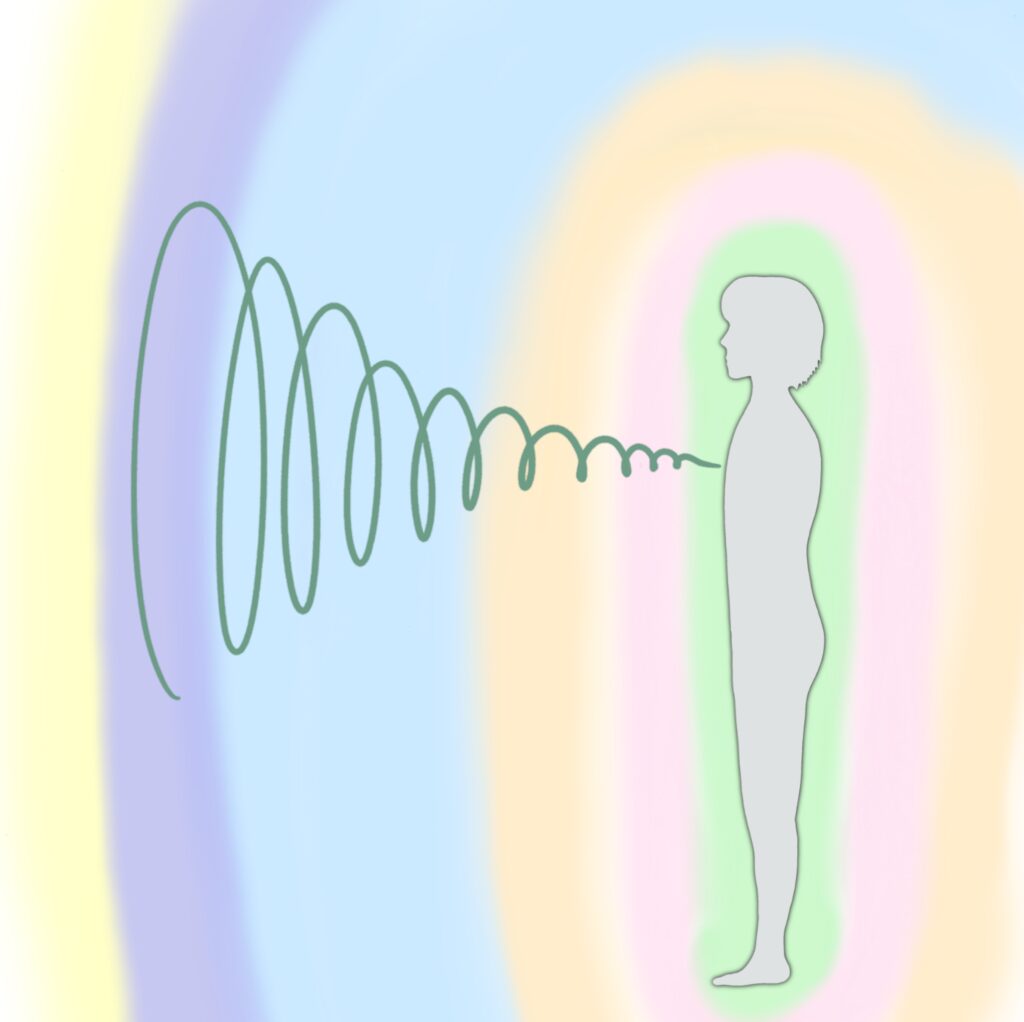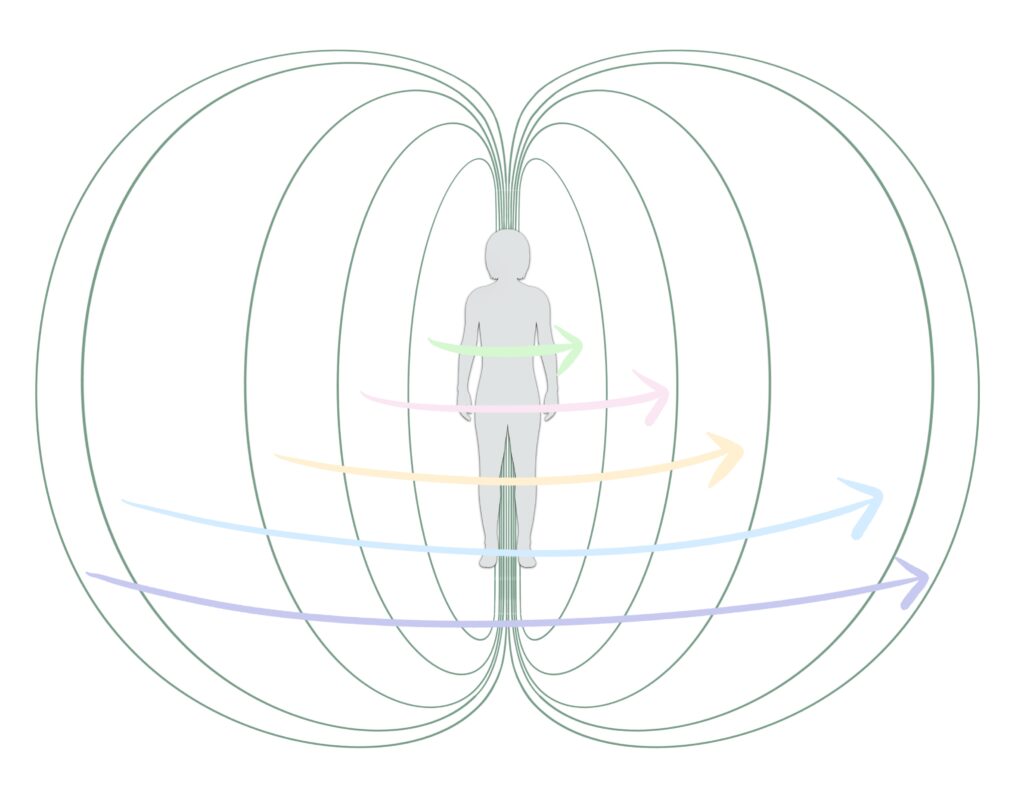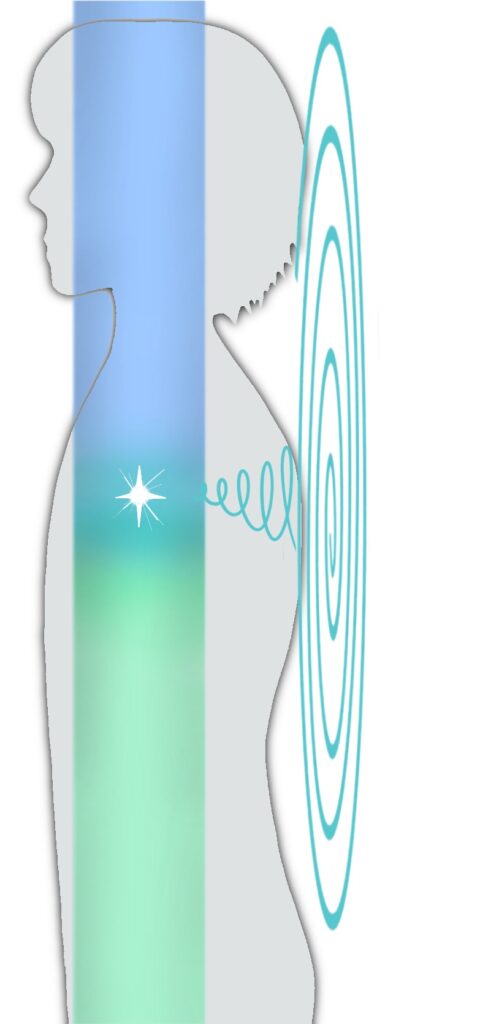The chakra system is an intelligent, dynamic, and fundamental energetic yet mechanical structure. Including the chakras themselves, it consists of seven unique but connected parts, like gears in a machine, that work together to maintain a healthy flow of life-giving energy. We rely on that energy to meet our moment-to-moment needs, whether we’re active or asleep.
The chakra system regulates, supports, encourages, and moderates all life experiences. It is the mechanism that relays energy and information among our body, emotions, memory, mind, and intuition.
Let’s take a brief look at what these seven components do, how they appear when they’re healthy, and what can happen when they’re not.
1. Chakra Vortexes
The chakra vortex is the part of the chakra system that most people have heard about. When it’s healthy, its vortex extends from the skin through all layers of the aura to its outer edge.
As the chakra turns, it exchanges information with your body, emotions, memory, mind, and intuition.

Figure 1: A healthy heart chakra vortex reaches through all layers of the aura.
Chakra vortexes are two-way streets. Energy flows both toward and away from the body. As it flows in, you are nourished, informed, and inspired and receive information about what you truly think and feel. On the outflow, you express yourself and act upon this information.
In this way, your mind can know your feelings; your emotions can understand your thoughts and memories; and your body can receive all the information it needs to make good decisions.
When your chakra vortexes are healthy, you can:
- Get information as you need it.
- Receive what you need and let go of what you don’t.
- Think more clearly.
- Enjoy creativity and inspiration as needed.
- Feel confident and self-assured.
- Give and receive in equal measure.
When your chakra vortexes aren’t healthy, you may:
- Experience issues involving your feelings, memory, and mind.
- Get stuck in limiting beliefs.
- Find your creativity and potential curtailed.
- Feel doubt about your self-identity.
- Lack self-control.
- Experience prolonged recovery times.
- Have difficulty receiving.
- Feel unmotivated, apathetic, or lethargic.
- Have poor career opportunities.

Figure 2: A healthy, narrow central chakra channel, typical of a healthy but sedentary person. Blue arrow shows inflow of heaven energy; green arrow shows inflow of earth energy.
2. The Central Chakra Channel
The central chakra channel (CCC) is a vertical channel that runs through the center of the body (when you’re standing). It extends above the head and below the feet. When healthy, it’s about four to six inches in diameter.
The purpose of the CCC is to funnel life-giving heaven energy down from above your head and earth energy up from below your feet. The sources above your head and below your feet are opposites, but both are essentially and richly nourishing for your body. They can also represent yang and yin, positive and negative, and masculine and feminine.
Both of these energies are essential, and they feed your body in different ways.
Ideally, energy should run smoothly and continuously through the central channel, diminishing in intensity only during sleep. It should neither pool nor become constricted. If it does, you may feel ungrounded, uncentered, exhausted, or burned out. You might suffer from poor vitality, chronic infections, or an inability to gain strength even with exercise.
3. Chakra Intelligence Centers
Each of the seven chakras has an intelligence center located inside the central chakra channel, directly behind the chakra vortex. These intelligence centers function like the brains of the individual chakras, as well as the collective brain of the entire chakra system.
When they’re healthy, the seven chakra intelligence centers appear like bright stars in the center of the central chakra channel. Together, they regulate and govern the workings of the body, emotions, memory, mind, and intuition.

Figure 3: The intelligence center at the heart chakra.
More specifically, the intelligence centers govern how much heaven and earth energy feeds the chakras. At the end of the day, it allows leftover energy to be stored in the chakra reservoir to serve us when we need to draw upon our energy reserves.
Chakra intelligence centers also determine how much energy the body requires, and can speed up or slow down the amount of life energy entering the body through the central channel.
The chakra intelligence centers are fractally related to the cell nuclei and, more specifically, to the DNA inside them. The relationship is close. Collectively, the DNA influence the chakra intelligence centers, although they can also act on their own.
When people refer to chakras as energy centers, they may be referring to the intelligence centers instead.
4. The Personal Vortex
In addition to chakra vortexes, energy practitioners generally agree that the body is surrounded by an aura.

Figure 4: The personal vortex. Arrows denote that all layers of the aura are moving in the same direction.
Many recognize its layers, which correspond to the emotions, memory, mind, and intuition. But few recognize that a healthy aura also turns in whole around the body. It’s somewhat similar to the jet stream that carries weather around our planet. (You can learn more about how the aura rotates here.)
A healthy aura that rotates around the body is called a personal vortex. Its toroidal shape is determined by your body’s magnetic field.
The central chakra channel lies at the center of the toroid, which means it also rotates left to right, or right to left. It is the core of the personal vortex.
Key functions of the personal vortex include drawing life-giving energy into the body, attracting healthy and helpful experiences, and deflecting unwanted energies and potentially harmful experiences.
A healthy personal vortex gives you a sense of self-confidence, self-sufficiency, and self-preservation. It helps you stay focused, give and receive in equal measure, and feel comfortable regardless of your location. It also regulates how efficiently your energy is used or wasted.
5. The Anterior Micro-vortex
A chakra intelligence center connects to its chakra via a small vortex called the anterior micro-vortex, which is located inside the body. This part of the chakra system acts like the transformer in your home that converts the high-voltage electricity coming in to a lower voltage that’s safe for you to use.

Figure 5: The small black vortex denotes the anterior micro-vortex.
Likewise, the anterior micro-vortex transforms the high energy inside the central chakra channel to a more usable version that fuels and feeds the chakras.
When people refer to chakras as energy centers, it may be because of the unusual energy that you can palpate at the junction between the anterior micro-vortex and the chakra vortex itself. At this junction, energy jumps from the micro-vortex to the chakra vortex. This creates a continual series of sparks that spur movement in the chakra vortex.
When your anterior micro-vortex is healthy, you feel generally positive, peaceful, perhaps even joyful, and certainly grateful.
When it isn’t healthy, it moves through a series of increasingly significant anomalies. At first, you might feel disconnected from yourself and your feelings, separate, or alone. But as the anomalies progress and become more serious, you may experience deepening degrees of sadness and hopelessness.
Three or more anterior micro-vortexes that display a downward spiral are often associated with depressing feelings.
6. The Posterior Micro-vortex

Figure 6: A healthy posterior micro-vortex reaches to the skin.
Behind the chakra intelligence center lies the posterior micro-vortex. It is larger than its anterior counterpart and also rooted in the intelligence center. But its vortex faces backward and attaches to the chakra reservoir.
Another difference between the two micro-vortexes is that the one in the front is highly charged and carries intense energy. The posterior micro-vortex is the opposite. It carries energy left over from the day, which is practically empty of charge.
A healthy posterior micro-vortex is essential for good sleep health and waking up well rested. It determines how well and easily you can let go of any troubles you may have, relax, and find peace.
With healthy posterior micro-vortexes, you have the ability to calm your thoughts, emotions, and body when needed, settle your energies, and fall asleep at bedtime.
7. The Chakra Reservoir

Figure 7: This healthy heart chakra reservoir is about 24″ in diameter. Ideal is 30”.
If you’ve ever wondered where your body keeps its energy reserves, it’s here, in the chakra reservoir.
The chakra reservoir is a flat spiral that’s somewhat concave, like a tortoise shell. Its maximum diameter is 30 inches, although 24–30 inches is considered healthy. A spiral 15–21 inches wide is moderately healthy, 6–12 is deficient, and three inches or under is depleted.
The spiral reservoir may also have some thickness. Minimum is about one-half inch, and maximum is about three inches.
The chakra reservoir has two main functions: to collect and store energy and information for later use, and to provide protection. The chakra reservoir shields us from the negative and unwanted thoughts and feelings that other people might throw in our direction.
While the moving personal vortex can deflect unwanted energy, the reservoir shields us from any that may be strong enough to get through. When our reservoirs are well filled, we might not even be aware of the threat, other than perhaps in an intuitive sense. Our energy field remains unflustered and fully protected.
When your reservoirs are well filled, you also have a great deal of stamina and resilience, and you are capable following through on the commitments you make, whether they involve relationships, projects, or personal goals.
Working with the Chakra System
Each of the seven parts of the chakra system can be evaluated, assessed, and then corrected.

Figure 8: All seven components of the chakra system.
To do a comprehensive chakra evaluation, you start by palpating and identifying each part of the chakra system, at each chakra. A set of typical anomalies has been catalogued for each of these parts, which you then record on an evaluation sheet.
These are the key energetic factors that interfere with your health and ability to self-maintain, self-regulate, and self-heal.
Each anomaly has a meaning or designated effect on how you feel. Assessing these meanings and tying them together with your symptoms gives you an overall sense of the underlying energetic factors contributing to your symptoms.
By identifying the anomalies in order of their impact, you can decide what chakra correction steps to take to alleviate the anomalies and improve your well-being.
Chakra anomaly evaluation, assessment, and correction is done using the Applied Chakra Analysis method, which you can practice in the comfort of your home. It can also be easily incorporated into a healing arts practice.
You can learn how to work with your own chakras in GDI 122: The Applied Chakra Analysis Method.
The Gemstone Therapy Institute Diamond Therapy certified practitioners are qualified to provide clients with comprehensive chakra evaluation and correction. Visit our practitioner directory and contact them if you are interested.
